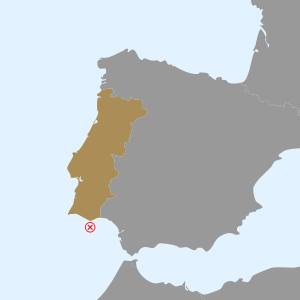Nuestra Señora de las Mercedes
_by_Francis_Sartorius%2C_National_Maritime_Museum%2CUK.jpg) The sinking of the Mercedes | |
| History | |
|---|---|
| Name: | Nuestra Señora de las Mercedes |
| Launched: | Havana, Cuba, 1786 |
| Fate: | Sunk by the British 5 October 1804 |
| Notes: | Thought to be the wreck discovered by Odyssey Marine Exploration, codenamed "Black Swan"[1] |
| General characteristics | |
| Armament: | 36 guns |
The Nuestra Señora de las Mercedes (Our Lady of Mercy in English) was a Spanish Navy frigate which was sunk by the British off the south coast of Portugal on 5 October 1804 during the Battle of Cape Santa Maria. At the time of the naval action Spain and England were at peace with each other. The Spanish frigate was part of a small flotilla sailing from Montevideo to Cadiz, transporting silver, gold, vicuna, cinnamon and quinoa. The other ships in the flotilla were the Medea, Santa Clara and Fama.
The flotilla was intercepted by a British Navy task force, commanded by Graham Moore aboard HMS Indefatigable, and ordered to change course and proceed to a British port for inspection. The Spanish commanding officer, brigadier José de Bustamante y Guerra (1759-1825) objected that the two nations were at peace, declared that they would not comply with the order, and ordered battle quarters, despite being outgunned and outnumbered. A single shot from the HMS Amphion, commanded by Samuel Sutton, hit the ship's magazine causing an explosion that sank the ship. 250 crewmen were lost, and 51 survivors were rescued from the sea. The other three vessels were interned in Britain. Her wreck has been compared with that of the USS Arizona.[2]
Salvage
A wreck discovered by Odyssey Marine Exploration, code-named "Black Swan",[1][3] has been declared to be the Mercedes. Odyssey recovered almost 500,000 silver and gold coins from the wreck, and transported them to the United States.
The CBC documentary "Secret World of Gold", which traces the history of gold items, referred to a shipwreck found off the coast of Portugal by an Odyssey Marine vessel based in Tampa, Florida. Peru attempted to claim the treasure as being originally plundered by the Spanish. However, a court case decided that the Spanish government was the rightful successor of interest because at the time of the wreck, Peru was considered a Spanish colony and not a separate legal entity, therefore it had no legal standing to be entitled to the proceeds of the lawsuit.

A U.S. federal court and a panel from the United States Court of Appeals for the Eleventh Circuit have upheld the Spanish claim to the contents of the ship; Spain took control of the treasure in February 2012.[4] A very small number of coins and effects recovered from the ship were deposited in Gibraltar, because they showed clear signs coherent with an internal explosion on the ship and thus confirmed Spanish claims to the wreck being that of the Nuestra Señora de las Mercedes. They were not returned to Spain until 2013, when a court finally ordered Odyssey Marine to return the missing pieces.
Exhibition
Spanish Naval Museum along with National Archaeological Museum of Spain showed the recovered treasure in the exhibition "The last trip of the frigate Mercedes. A recovered cultural treasure" («El último viaje de la fragata Mercedes. Un tesoro cultural recuperado» in Spanish) from June to December 2014.[5]
In 2015 Spanish government commanded an expedition to extract most valuable pieces of the shipwreck and it was proved that Odyssey recovered coins damaging marine soil and the remaining parts of the ship.[6]
See also
References
- 1 2 Treasure hunters ordered to return £250m of loot to Spain -The Telegraph, 4 June 2009
- ↑ http://cultura.elpais.com/cultura/2015/01/14/actualidad/1421265607_906473.html Confesiones del ‘caso Odyssey’, El País, (01/15/2015) (SPA)
- ↑ Black Swan Project
- ↑ Cultural Property & Archaeology Law (20 February 2012). "Federal Court Orders Treasure Hunters Return Coin Trove to Spain". Retrieved 28 July 2014.
- ↑ El último viaje de la fragata Mercedes. Un tesoro cultural recuperado. (in Spanish)
- ↑ A canon and 11 valuable coins are recovered from the Mercedes (in Spanish)